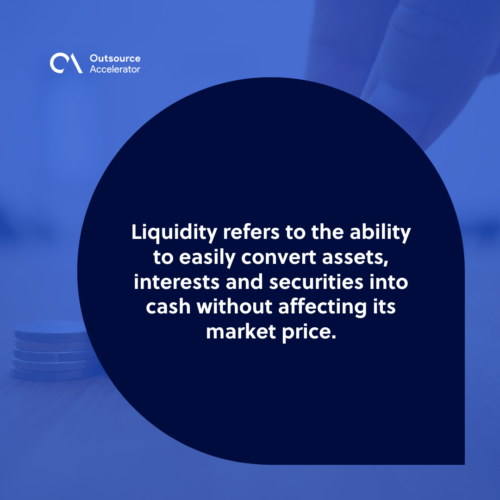Liquidity
Definition
What is liquidity?
Liquidity refers to the ability to easily convert assets, interests and securities into cash without affecting its market price. Generally, cash is considered the most liquid asset as it can be easily converted into other assets. But since it is a fully liquid asset, it may be affected by inflation.
Liquidity is important because it allows individuals to pay for basic living expense. It can also be a good form emergency backup, in case of any unexpected financial setback, crisis, or unforeseen happenings.
High liquidity vs low liquidity
High liquidity is when an asset can be sold for its expected value. In terms of investment, Treasury bills (T-Bills) is one example of highly liquid asset as investors can sell them any time at a high market price.
Low liquidity is when an asset has less opportunity to trade in the market. It is often referred to as “illiquid assets”. These are assets that cannot be easily and quickly sold without losing its real value. Examples of illiquid assets includes real estate, cars, collectibles, and fine arts.

Two main types of liquidity
These are the two main classifications of liquidity:
Market liquidity
Market liquidity refers to the conditions of a market (either stock market or forex market) that allows assets to be bought and sold at stable prices.
A liquid market is less risky as it attracts more investors and it adds to more desirable market conditions. Whereas an illiquid market has fewer buyers and sellers, this usually happens during certain financial crisis.
Accounting liquidity
On the contrary, accounting liquidity refers to the ability of an individual or company to pay their financial obligations (most likely debts). They use available liquid assets they own, such as cash, marketable securities, accounts receivable, and inventories.
How to measure Liquidity
Calculating liquidity is done through ratio analysis. This process involves comparison between an individual or a company’s assets and liabilities. Liquidity ratios will help the company’s stakeholders, and external parties evaluate the business’s liquidity.
Here are the most common measures that businesses usually use to analyze liquidity.
Cash ratio
Cash ratio defines liquid assets specifically as cash or equivalents. It evaluates the business’s ability to stay debt-free in case there’s an unforeseen event. It is calculated by the total amount of cash divided by the liabilities.
Current ratio
Current ratio measures the number of current assets against liabilities. In general, businesses work to maintain a current ratio between 1.5 to 2.5 which means that their working capital is managed well.
It is considered the simplest measure as it determines the short-term liquidity, which is the ability of the business to repay debt as they come due.
Quick ratio
Quick ratio is also known as the acid-test ratio. It eliminates the inventories and other current assets that are not easy to turn into cash. It is calculated by adding cash and cash equivalents, accounts receivables, and short term investments, divided by the current liabilities.
A company must care about the liquidity of its business. Liquidity is a key feature of a healthy business. Businesses must always have available cash to pay off their debts or obligations. Consequently, this might be a significant help in case there is a liquidity crisis or, worse, bankruptcy.







 Independent
Independent




